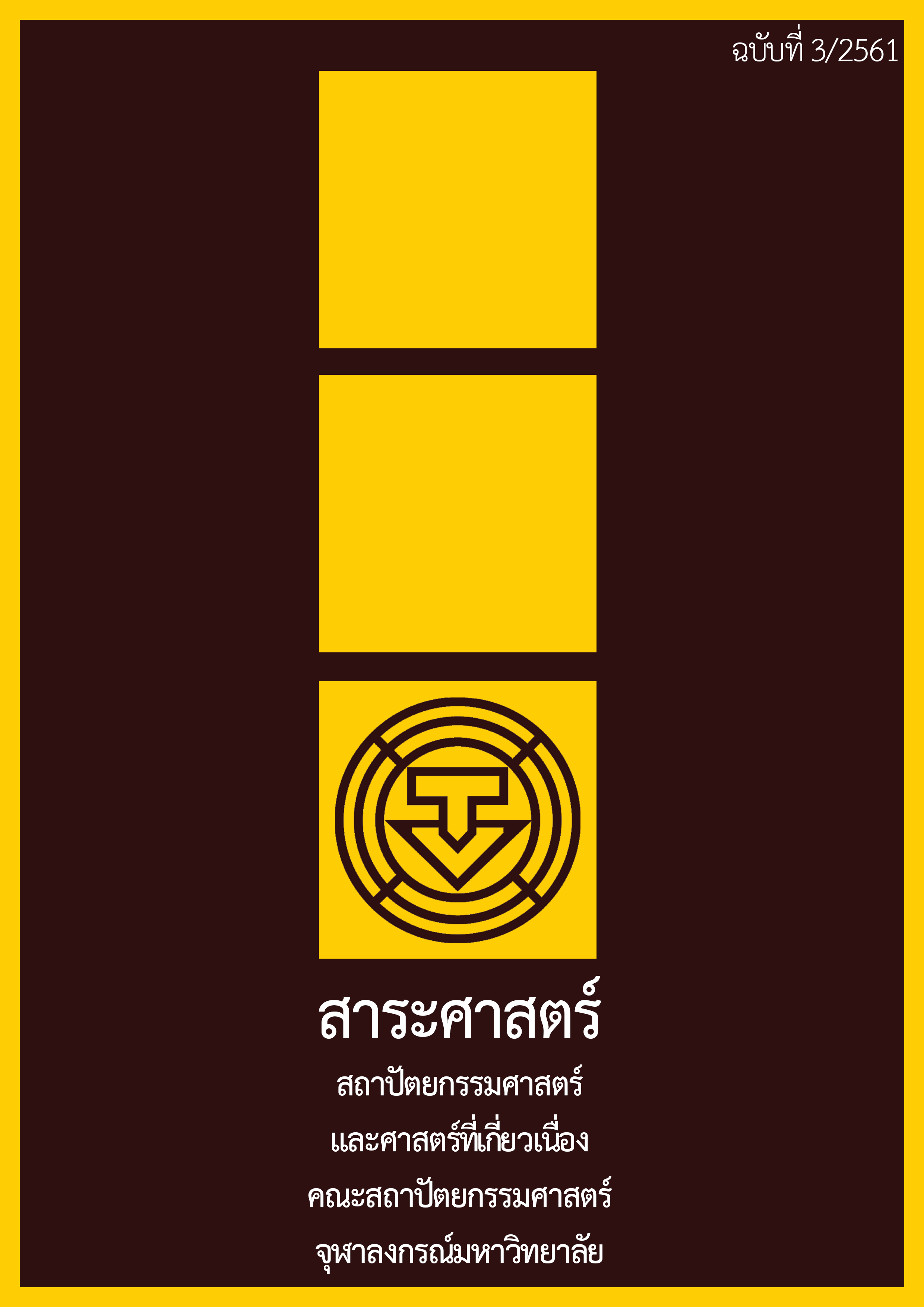Prefabricated Roof Structure : Galvanised Steel Truss
Main Article Content
Abstract
Originally, the trend is using woods to make the roof structures its mechanical property can handle the bending very well. Nowadays the price of woods is going up and it’s not durable enough to external conditions. The use of steel is replaced woods. As the steel can handle less bending than woods, it needs the shores to handle the structures in order to reduce the facial area and the light weight roof structure. However the steel can have rusted easily therefore Galvanised Steel is used instead. Galvanised Steel can handle more compression and more tension, has cheaper price, and can protect the steel from rust than pure steel. Thus the facial area of the Galvanised Steel is reduced, but the structures of roofs need to change into the Galvanised Steel Truss because it still needs some supports for bending.
The Galvanised Steel Truss is produced in one factory in order to cut and folded into certain styles wanted in another factory. After that the factory transports and piles them at construction sites. The smooth area is needed to assemble the truss and uses construction workers’ forces to carry pieces of the truss up to establish them to make roofs. From the case study of Pruksa Real Estate Public Company’s single house, it shows that there are 119 piece of the Galvanised Steel to assemble the 6 truss structures. The length of truss seems to be obstacle for work. There are some damaged occurred as the Galvanised Steel’s pieces. Moreover, the smooth area is necessary for assemble the truss. It’s one of problems due to the road part is the last step of the construction project.
The advice is to use other place to assemble the Galvanised Steel Truss and make them into proper lengths that relate to the conditions of transportations. The 3 finished styles of the Prefabricated Roof Structures: Galvanised Steel Truss are divided the original 6 structures into 2 parts and construct them to parallel one another in the style as truss before. The Galvanised Steel Truss has 12 structures, 119 pieces of Galvanised Steel. Another style is constructing them into 2 parts like the first style, but establishing them paralleling into serration pattern which need to add 12 structures of the Galvanised Steel Truss and 151 pieces of Galvanised Steel. The last style is changing the pattern of truss by using the hip rafter of roofs. There are 8 structures of Galvanised Steel Truss and 106 pieces of Galvanised Steel. We can see then, that the Galvanised Steel Truss could establish at the factory and transport to the construction site. Whereas it still is the same truss or pieces of Galvanised Steel are slightly increased and design the truss to another Prefabricated Roof Structures.
Article Details
References
กวี หวังนิเวศน์กุล. การออกแบบโครงสร้างอาคารเหล็ก. พิมพ์ครั้งที่ 3. กรุงเทพมหานคร: โรงพิมพ์ หจก.รุ่งแสงการพิมพ์, 2553.
ชาคริต วิชชาบุญศิริ. “ การศึกษาเปรียบเทียบการก่อสร้างระหว่างโครงหลังคาสำเร็จรูปและโครงหลังคาเหล็กรูปพรรณสำหรับบ้านเดี่ยวขนาดกลาง.” วิทยานิพนธ์ปริญญามหาบัณฑิต สาขาวิชานวัตกรรมการพัฒนาอสังหาริมทรัพย์ คณะสถาปัตยกรรมศาสตร์และผังเมือง มหาวิทยาลัยธรรมศาสตร์, 2553.
ทักษิณ เทพชาตรี และอัครวัชร เล่นวารี. พฤติกรรมและการออกแบบโครงสร้างเหล็ก. พิมพ์ครั้งที่ 3. กรุงเทพมหานคร: สำนักพิมพ์จุฬาลงกรณ์มหาวิทยาลัย, 2555.
ธนพล สินธุยนต์. “แนวทางการนำระบบเสา-คานสำเร็จรูปมาใช้ร่วมกับการก่อสร้างระบบเดิมในโครงการบ้านจัดสรร.” วิทยานิพนธ์ปริญญามหาบัณฑิต ภาควิชาเคหการ คณะสถาปัตยกรรมศาสตร์ จุฬาลงกรณ์มหาวิทยาลัย, 2545.
บริษัท ปูนซีเมนต์ไทย จำกัด (มหาชน). Material Guide. กรุงเทพมหานคร: บริษัท ปูนซีเมนต์ไทย จำกัด (มหาชน),
2558.
พิภพ สุนทรสมัย. การก่อสร้างโครงสร้างเหล็ก. พิมพ์ครั้งที่1. กรุงเทพฯ: สมาคมส่งเสริมเทคโนโลยี (ไทย-ญี่ปุ่น), 2550.
มนัส อนุศิริ. การออกแบบโครงสร้างไม้และเหล็ก. พิมพ์ครั้งที่11. กรุงเทพฯ: ซีเอ็ดยูเคชั่น, 2548.
วินิต ช่อวิเชียร. การออกแบบโครงสร้างเหล็ก. พิมพ์ครั้งที่1. กรุงเทพมหานคร: ภาควิชาวิศวกรรมโยธา คณะวิศวกรรมศาสตร์ จุฬาลงกรณ์มหาวิทยาลัย, 2539.
สนั่น เจริญเผ่าและวินิต ช่อวิเชียร. การออกแบบโครงสร้างไม้และโครงสร้างเหล็ก. พิมพ์ครั้งที่ 6. กรุงเทพมหานคร:ภาควิชาวิศวกรรมโยธา คณะวิศวกรรมศาสตร์ จุฬาลงกรณ์มหาวิทยาลัย, 2527.
สุกฤต อนันตชัยยง. “ การศึกษาและเปรียบเทียบการก่อสร้างบ้านพักอาศัย ด้วยชิ้นส่วนคอนกรีตสำเร็จรูประบบเสา-คานกับการก่อสร้างแบบทั่วไป : กรณีศึกษา หมู่บ้านคุณาลัย บางขุนเทียน.” วิทยานิพนธ์ปริญญามหาบัณฑิต ภาควิชาสถาปัตยกรรมศาสตร์ คณะสถาปัตยกรรมศาสตร์ จุฬาลงกรณ์มหาวิทยาลัย, 2545.


